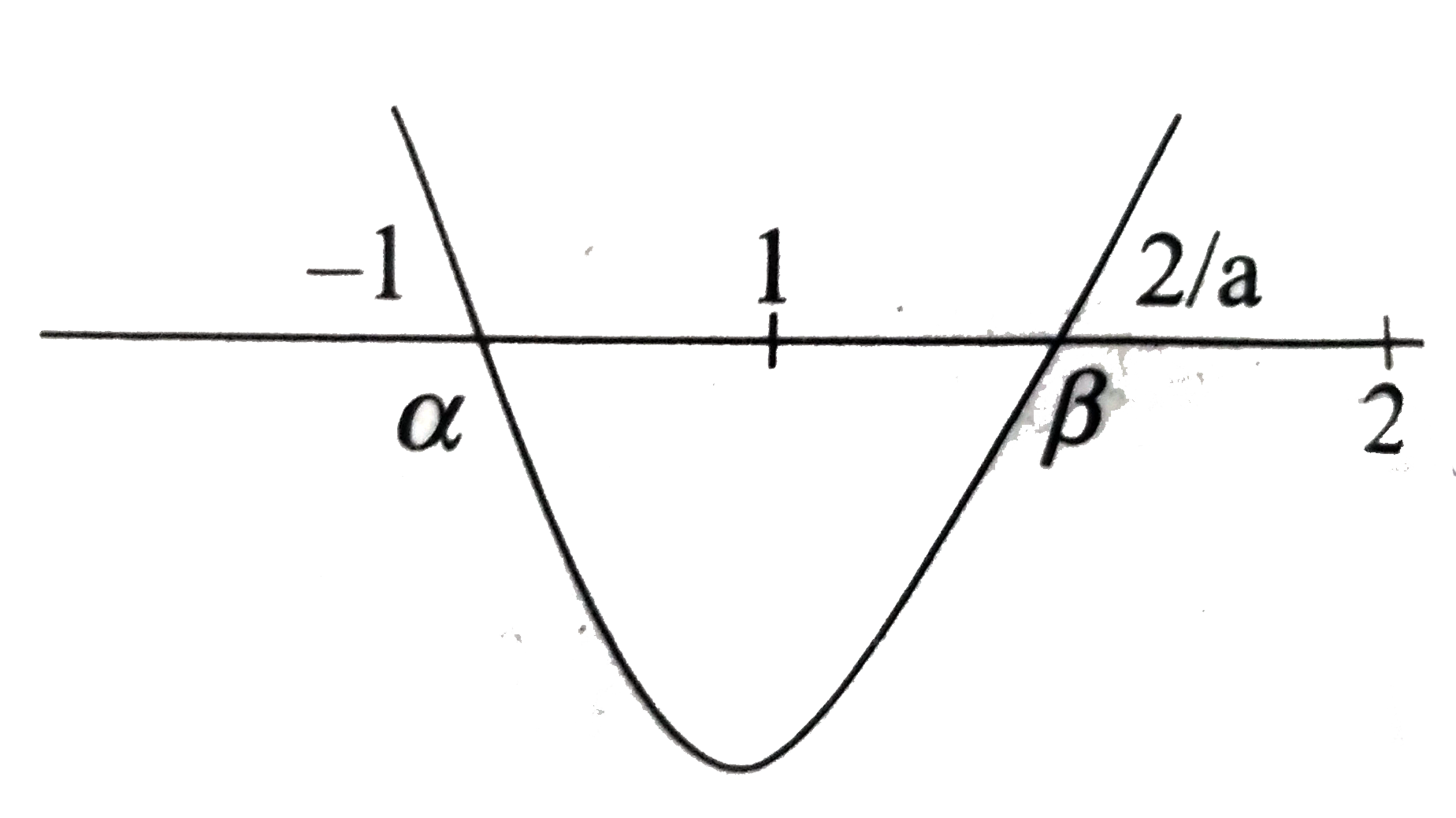The set of values of a for which ax2+(a−2)x−2 is negative for exactly two integral x, is (0,2) b. [1,2) c. (1,2] d. (0,2]Solution in Tamil
[−1,1]
[1,2)
[−1,1]
[-2,-1])
The correct Answer is:B
(b) Let f(x)=ax2+(a−2)x−2
f(x) is negative for two integral values of x, so graph should be vertically upward parabola
i.e., a>0
Let two roots of f(x)=0 are α and β, then
α, β=−a(a−2)±(a+2)2a
⇒a=−1, β=2a
⇒1<β≤2
⇒1<2a≤2
⇒a∈[1,2)

Topper's Solved these Questions
- BOOK - CENGAGECHAPTER - THEORY OF EQUATIONSEXERCISE - Comprehension12videos
THEORY OF EQUATIONS
- BOOK - CENGAGECHAPTER - THEORY OF EQUATIONSEXERCISE - Multiple Correct Answer6videos
THEORY OF EQUATIONS
- BOOK - CENGAGECHAPTER - STRAIGHT LINESEXERCISE - JEE Advanced Previous Year4videos
STRAIGHT LINES
- BOOK - CENGAGECHAPTER - THREE DIMENSIONAL GEOMETRYEXERCISE - Question Bank12videos
THREE DIMENSIONAL GEOMETRY
Similar Questions
p(x) be a polynomial of degree at most 5 which leaves remainder - 1 and 1 upon division by (x−1)3 and (x+1)3respectively, the number of real roots of P(x)=0 is
02:08View SolutionIf c≠0 and the equation p/(2x)=a/(x+c)+b/(x−c) has two equal roots, then p can be (√a−√b)2 b. (√a+√b)2 c. a+b d. a−b
05:36View Solutionabout to only mathematics
05:05View SolutionThe equation of the plane which has the property that the point Q(5,4,5) is the reflection of point P(1,2,3) through that plane, is ax+by+cz=d where a,b,c,d∈N. Find the least value of (a+b+c+d).
02:55View SolutionThe function y=sqrt(2x-x^(2))(A) increases in (0,2)(B) increases in (0,1) but decreases in (1,2)(C) Decreases in (0,2) (D) Increases in (1,2) but decreases in (0,1)
02:42View SolutionAll the values of 'a' for which the quadratic expression ax2+(a−2)x−2 is negative for exactly two integral values of x may lie in [1,32] (b) [32,2) [1,2) (d) [−1,2)
View SolutionThe range of function y=[x2]=[x]2,x∈[0,2] (where [.] denotes the greatest function), is {0} b. {0,1} c. {1,2} d. {0,1,2}
05:09View SolutionIf [[x, 4, 1]] [[2,-1,2] , [1,0,2] , [0,2,-4]] [[x], [4], [1]]=0 then find x
05:00View SolutionLet f''(x)>0 and ϕ(x)=f(x)+f(2−x),x∈(0,2) be a function then the function ϕ(x) is (A) increasing in (0,1) and decreasing (1,2) (B) decreasing in (0, 1) and increasing (1,2) (C) increasing in (0, 2) (D) decreasing in (0,2)
02:58View SolutionIf A=[123−5],B=[1002] and X be a matrix such that A = BX , then X is :
03:48View SolutionAll the values of 'a' for which the quadratic expression ax2+(a−2)x−2 is negative for exactly two integral values of x may lie in (a) [1,32] (b) [32,2) (c) [1,2) (d) [−1,2)
05:17View SolutionIf set of values a for which f(x)=ax2−(3+2a)x+6,a≠0 is positive for exactly three distinct negative integral values of x is (c,d] , then the value of (c2+4|d|) is equal to ________.
05:57View SolutionIf A=[123−5] and B=[1002] and X is a matrix such that A=BX, then X=
05:14View SolutionThe value of c in the interval (0,2) that functions f(x)=x(x-1)^(2),x in[0,2] For the medium satisfies the theorem, is
02:10View SolutionThe value of c in the interval (0,2) that functions f(x)=x(x-1)^(2),x in[0,2] For the medium satisfies the theorem, is
02:57View SolutionAll the values of 'a' for which the quadratic expression ax2+(a−2)x−2 is negative for exactly two integral values of x may lie in [1,32] (b) [32,2) [1,2) (d) [−1,2)
02:32View Solution

